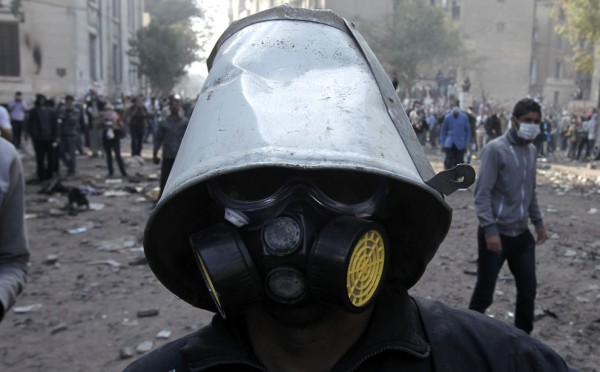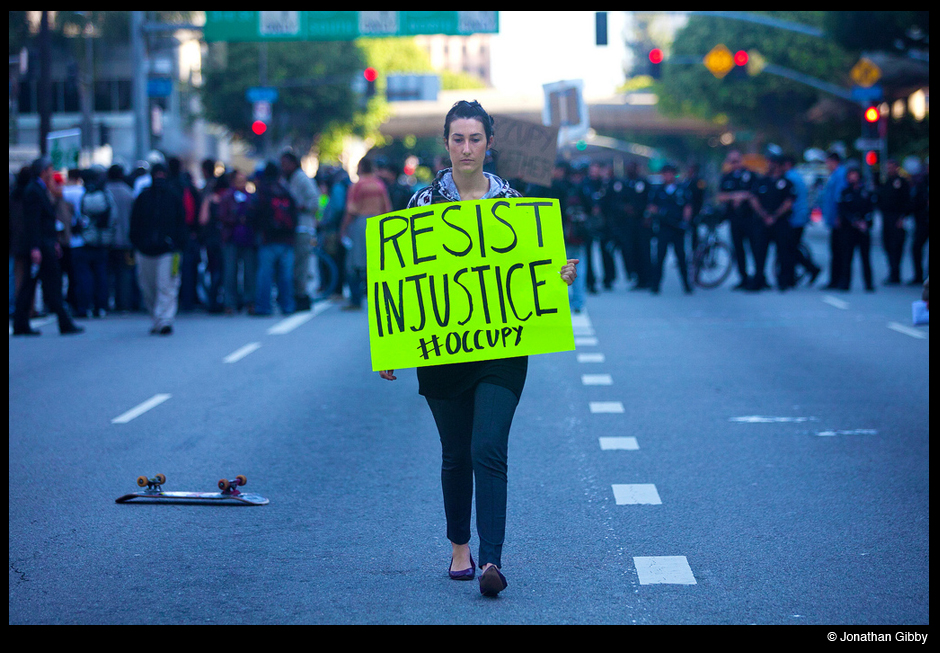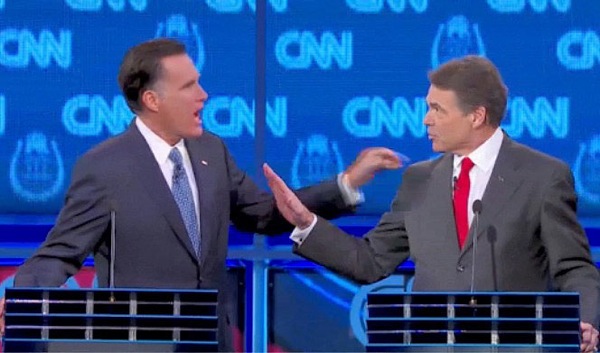Notes
Simeon to Cyborg: Is Anti-Democratic Meme (& "Arresting" Pics) Dooming Progressive Protest?
Instead of last spring’s inspiring images of democratic solidarity, the images now coming out of Cairo are becoming increasingly surreal.
This one is getting a lot of play–the guy is so distinctive that you can even see another photographer in the picture trying to get his shot. And what’s not to like? The bizarre gas mask is hardly standard issue (where did he find that?), and its white rubber both contrasts with his dark clothing and matches the white smoke pouring out of the tear gas canister. The smoke streams back along his path as he is running forward, for this is definitely an action shot. (Think of how many demonstration photos feature relatively passive postures: sitting, standing, or milling about, with raised hands, signs, and banners displayed for the media having to stand in for more extended or dramatic action. Look, for example, at the rest of the people in this photo.) Revolutionary action wearing an alien, almost unintelligible mask, the photo captures key features of a popular revolt defined, like so many demonstrations today, much more by its opposition to a corrupt establishment than by a clear idea of what an alternative future might bring.
And that’s where I get a bit worried, as the photo may be fitting too well with the anti-democratic meme of late that progressive movements are incoherent. (Back in the day, the left was tarred with being a rigid, centralized, international organization adhering strictly to the explicit ideological doctrines of Soviet communism; now that the Cold War is over, I guess it makes sense that the left, sans directives from Moscow, would have to be disorganized and inarticulate. As long as you’re outside of the reality-based community, that is.) Unlike many other images of painted faces and massed bodies, the masked man doesn’t seem to link with any political aspiration or populist movement. Because his pending action of throwing the canister mirrors the original assault, he seems equally prone to violence while this false equivalence cancels out any sense of political difference.
Worse, he looks grotesquely simian, as if political demonstrations were a form of devolution. Worse yet, this falling backward is also a cyborg projection where organic and mechanical natures have been horribly fused. The close fitting headpiece reveals a human skull in all its distinctiveness and fragility, yet the mechanical mask destroys any hope of wholly human sympathies. The bare hands make the dark clothing seem like a pelt, while the loping limbs suggest a life alternating between predation and flight. The bag hanging below his waist looks like another limb and thus another example of organic life distorted, whether by bad science or the pressures of a harsh environment. Five-limbed with a machined face, there is little basis for identification. It seems that only violence is legible, and can calls for restoring order be far behind?
And yet, the more strange he appears, the more likely another interpretation also applies. I’ve posted a number of times about how photojournalism is revealing the often surreal nature of violence in our time. In addition, I’ve suggested in several posts that a corresponding political aesthetic is emerging as well, one in which the modern apparatus of power can look increasingly medieval. Admittedly, sometimes costumes are just that, and the surface rarely expresses what lies below unerringly, but I believe that these changes in style can reflect far more troubling changes in political relationships.
To take a page from science fiction–indeed, one of its most insistent and important lessons–technological progress can proceed with and contribute to regression along every other dimension of human experience: social organization, economics, politics, culture, you name it. Thus, rather than merely supporting or undercutting the demonstrations, photos such as the one above might be working more prophetically to identify how a harmful future is emerging in the present. More to the point, they are showing not who is causing what, but how ordinary people are already coping with deprivations and more explicit forms of systemic violence, not least by adapting to those harsh conditions at the very moment that they are fighting against them.
Welcome to the future.
— Robert Hariman
(cross-posted from No Caption Needed)
(photos: Tara Todras-Whitehill/Associated Press and Mahmud Hams/AFP-Getty Images.)



Reactions
Comments Powered by Disqus